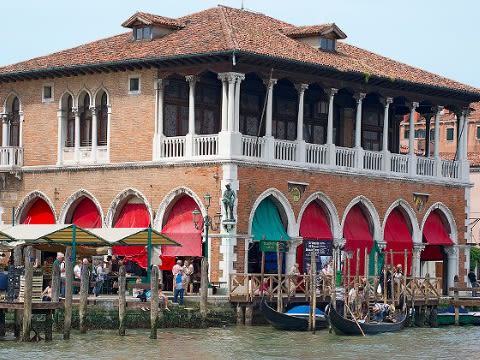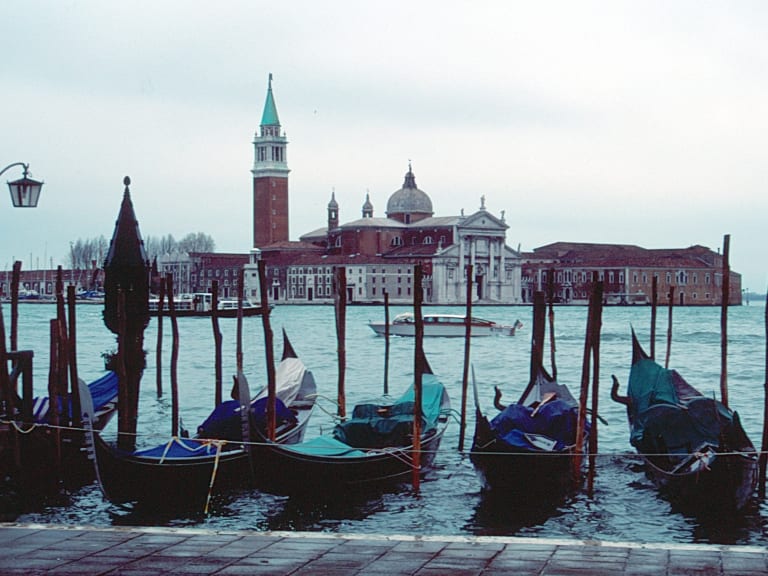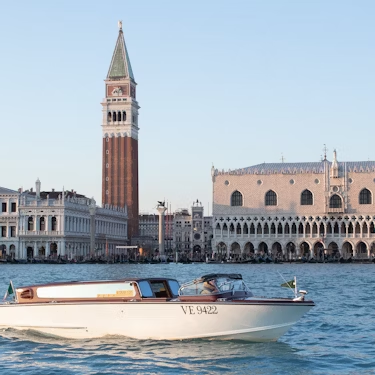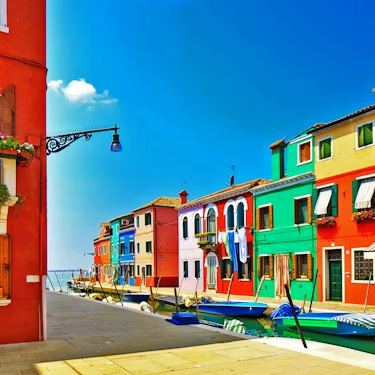More about: 10 Things to Do in Venice in November
After a few months in which thousands of tourists flock to see Venice's main attractions, the atmosphere becomes quieter in November. The pace slows down and it is the best time to stroll around the city's squares, streets and monuments without crowds.
In November, moreover, Venice celebrates some of its most intimate events, almost conceived only for Venetians. From All Saints' Day to the Festa della Salute, from the Commemoration of the Dead to St. Martin's Day, these celebrations reflect much more clearly the way of being and living of the inhabitants of the ancient Serenissima Republic.
1. Visit the opera at La Fenice

Whether you're an opera buff or not, going to the mythical La Fenice theater (which first opened its doors in 1792) should be on your list if you come to Venice in November.
Just to see its beautiful interior, its atrium and the Apollonian Rooms alone is worth attending a performance or, if you can't, visiting at another time. In addition, its proximity to St. Mark's Square and other monuments makes it an ideal place to end the day's tour.
Even in the month of November you will be lucky that there will not be so many tourists and you can enjoy its architecture without stress.
2. Taste the typical Venetian dishes of All Saints' Day

After having celebrated the last big holiday of October, Halloween, Venice focuses on another much more traditional event: All Saints' Day. As in the rest of the country, this is a holiday closely related to Catholicism and in which all the deceased are honored.
If you are in the city on these dates, you will see that this celebration has two different aspects in which you can participate. The first is religious, since all the temples in Venice celebrate special masses on that day.
The second aspect is closely related to gastronomy. Traditionally, it was customary to prepare a feast dedicated to the dead as a way of remembering them and showing respect. Nowadays, you will be able to find some typical dishes, as you can see in the gastronomic tours of Venice and its restaurants.
3. Visit the Doge's Palace without queuing up and with less tourists

Entering the Doge's Palace is one of the must-see sights on any trip to Venice. This, in high season, means having to stand in a considerable queue making the visit in the midst of a large number of tourists, but in November you can enjoy this building without crowds.
I assure you that this makes an important difference in the way you will perceive all the attractions of a palace that has been the residence of the Doges and the prison of the Republic of Venice.
The best way to see the interior is to hire a guided tour of the Doge's Palace to get to know what you are seeing. Generally speaking, on the tour you will see:
- La Scala d'Oro.
- The floor where the works of painters such as Tintoretto, Titian and Veronese are located.
- And the Bridge of Sighs, which communicated with the dungeons of the palace and that you can cross.
4. Climb the Campanile for a view of Venice

The month of November gives the city of canals a totally different atmosphere than in August in Venice or in other months of the year. In addition to the rain, sometimes the fog descends on the city creating a fascinating cloak.
The typical autumn light, more morbid, coupled with that fog can make climbing the Campanile of St. Mark's Basilica become a unique experience.
This bell tower of the extraordinary St. Mark's Basilica measures 98.5 meters and is the highest point in the city. The views are obviously great at all times of the year, but in autumn the city takes on an almost ghostly appearance.
5. Take a trip to Florence to enjoy the feast of the Tuscan Region

Those fortunate enough to be able to spend a week or so in Venice can afford to take more than one excursion elsewhere. If you have traveled at the end of November, I recommend visiting Florence in the midst of the Tuscany region festival.
This celebration is fairly recent, having only been held every November 30 since 2000. It celebrates the fact that Tuscany was the first place on the planet to abolish the death penalty, in 1786.
Although Florence has more than enough attractions to go to, attending the activities that take place during this celebration is very worthwhile.
6. Taste the castradina

Most of the celebrations that take place in Venice are reflected in its rich gastronomy. The festa della Salute could not be less and has its own traditional dish that is consumed in the days before and after November 21. If you like lamb, you can't miss the chance to try castradina.
It consists of a flavorful soup made with salted, smoked and seasoned lamb meat. To this base is added onion, wine and cabbage leaves. The traditional method of cooking castradina requires several hours of cooking, so many that the elders of the city say it must be simmered for a whole day.
If you are in Venice at this time you will have no problem finding this dish in the best restaurants in the city and doing a gastronomic tour of Venice.
7. Celebrate the Day of the Dead (Ognissanti)

On November 2, another holiday related to the Day of the Dead is celebrated. It is the Ognissanti, which could be translated as the Commemoration of the Dead. Although there are other cemeteries in the city, undoubtedly the most interesting is the one on the island of San Michele (St. Michael). Until Napoleon's invasion, burials in Venice took place in churches and Campi.
Many illustrious Venetians and foreigners are buried in the cemetery, such as Igor Stravinsky, Joseph Brodsky, Sergei Diaghilev, Ezra Pound and Luigi Nono. Likewise, it is worth looking for the bronze sculpture that Venetians call Sleeping Beauty. It is a representation of Sonia Kaliensky, a Russian aristocrat who committed suicide when she suffered a heartbreak during the 1907 carnival.
The best way to get around Venice to reach the island of San Michele is the Venetian vaporetto, as is the case in the rest of the city.
8. Become a child again at the San Martino Festivities

The commemoration of this saint is especially characterized by children. They take to the streets singing and shouting while the neighbors offer them sweets prepared for them. In case you go to Venice with children, it is possible that they can join the celebration and taste some sweets.
On that day it is also very traditional to eat a dessert with a curious shape. The sweet, a shortcrust pastry, is baked to resemble the figure of San Martino himself on horseback and carrying a sword and a cloak. You can buy it in almost every pastry shop and café in town.
The Feast of San Martino is one of Venice's lesser-known festivities, overshadowed by the February carnivals in Venice and the splendors of the Biennale. It is, however, a commemoration dear to the hearts of Venetians and one you should join if you happen to be in the city on the day of its celebration, November 11.
9. Join the Venetians at the Madonna della Salute

Venice celebrates the festa della Salute on November 21 every year. During this festivity, Venetians enjoy the food and the atmosphere created in front of the basilica of Santa Maria della Salute.
Its origin is quite particular: a plague epidemic decimated the Venetian population in 1630. As a celebration for the end of this epidemic, the Senate of the Republic of Venice ordered the construction of the Basilica of Santa Maria della Salute.
This origin explains the name of the celebration, Feast of Our Lady of Health in English. The temple is located in the setiere (neighborhood) of Dorsoduro and the municipality installs a temporary bridge over the Grand Canal so that all Venetians can reach it on that day.
Reasons to visit the basilica on this holiday
The church itself is well worth a visit for its beauty, but November 21 is the only day of the year when access to the area under the dome is allowed, as passage is normally limited by thick cordons.
According to legend, if you step on a bronze disk located right in the center of the church, under the large chandelier, your health will be great all year round.
10. Don't miss the Venice Biennale

November marks the end of the Venice Biennale, the most important artistic and architectural event in the world. Its origin dates back to 1895, when it was born with the purpose of promoting all kinds of artistic disciplines: cinema, music, theater, architecture, dance and visual arts.
Despite the name, activities are organized every year and alternate annually between the International Architecture Exhibition and the International Art Exhibition. The entire city participates in this event and the activities are divided into three locations: the national pavilions, the international headquarters and various buildings, deconsecrated churches and palaces distributed throughout Venice.
If you are traveling to Venice at this time I recommend that you go to a tourist office to get one of the specific brochures about the Biennale. In them you will be able to see the activities programmed at any given time and, thus, choose which ones interest you.
Weather in Venice in November

November in Venice is characterized by humidity, low sunlight and early morning fog. In addition, according to historical data, there are about six days of precipitation during the entire month.
It is always advisable to check the weather before traveling to be sure, but statistics show highs hovering around 12º and lows hovering around 5º. Keep in mind that the aforementioned humidity and wind make the wind chill lower.
Tourist arrivals in Venice in November

If there is any month that can be called low season in Venice, it is November. After the last throes of mass tourism in October and before the arrival of Christmas in Venice andCarnival, the city experiences a brief period of tranquility.
In practice this translates into lower prices on flights and hotels, as well as being able to walk the streets in a much quieter way. Likewise, queues at monuments are reduced to a minimum and the atmosphere becomes much more local and intimate.
Finding your way around Venice: its neighborhoods

Despite its small size, finding your way around a city like Venice is not easy. Its narrow streets and canals make it easy to get lost, even if you use a mobile app.
A good idea is to at least know the districts into which the city is divided. This will help you plan your tours and get an idea of where each place is located:
- San Marco: the most touristic and central part of the city, with most of the places to visit in a short stay.
- San Polo: located near the Rialto Bridge, this neighborhood is one of the liveliest in the whole city.
- Castello: the largest district of the city, from the area of the Doge's Palace to the Arsenale.
- Cannaregio: it is located to the north, just above the Grand Canal. It is the most populated of the city.
- Santa Croce: next to San Polo. Although it is the one that receives fewer tourists, its narrow streets and churches are very interesting.
- Dorsoduro: covers the southwest area and the island of Guidecca. It has a very student atmosphere and, therefore, lively.




